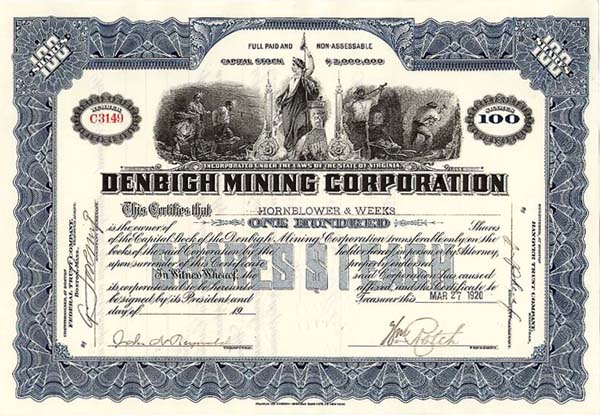Denbigh Mining Corp - Stock Certificate
Inv# MS1014 Stock
State(s):
Colorado
Years:
1920's
Color:
Bl
Mining Stock. Two superb vignettes of coal miners at work in the mines and a female figure in the center! Rare!!!
Denbigh Mining Corporation
This company is the reorganization of the Denbigh Silver Lead Mines Co, (see below) which went bankrupt in 1919 due to the market campaign of Thomas W. Lawson of “Frenzied Finance” fame. Owned property in Clear Creek and was dead by 1925 (Mines Register, 1925).
DENBIGH SILVER-LEAD MINES CO. COLORADO
Address: 85 Devonshire St., Boston, Mass.
Officers: W. Roch, pres.; J. F. Lindel, v. p.; G. A. Haskell, treas.; J. N. Reynolds, sec., all of Boston, Mass., with H. F. Wells and J. E. Berry, of Boston, J. J. Mendell of Manchester, Mass., and W. H. Perry of Beverly, Mass., directors. H. S. Bushnelle, mgr.
Inc. in 1916, in Colorado. Cap., $1,000,000; $1 par; all issued Listed on Boston Curb. Indebtedness, $20,000.
Property: leases and bonds for $250.000 on the properties of the Whiting Mining & Milling Co. and of the Terrible Dunderberg Mining & Power Co. These mines are one mile from Silver Plume, Clear Creek county. Properties have been worked for 40 years and comprise 43 patented claims, about 300 acres. The company controls a number of old-time producing mines, and the dump from the Seven-Thirty, Mammoth, Brown and Dunderberg workings, known as the "Big Slide in Brown gulch."
Ore: silver, lead and zinc occurring in a fissure vein in granite and schist. Vein dips 70° N. and strikes N. E. The sulphide pay-ore in each mine occurs in shoots, each over 250' long, and streaks- of varying size.
Development: by a working tunnel with 7 levels above it and 7 below it, reached by a 70° shaft, 600' deep. Method of working is by shrinkage sloping. Total extent of workings is about 5 miles. A winze 70' below deepest workings is in $50 ore for the entire length.
Equipment: includes hoist, pump, and 100-h p. compressor. Both water power and electricity are used. The 75-ton mill contains crushers, rolls, jigs, and tables, and can, it is said, treat the ore at a cost of $1 per ton. The manager estimates $39,000 needed to complete the new shaft, repair mill, and do other work.
Recent operations include a 3-compartment raise from the 14th to tunnel- level, a distance of 490', which when completed, will be the main working shaft. A double drum, motor-driven hoist will be installed. For the first 7 months of 1919, about 1,000' of sloping had been done.
Owners claimed that the mine has a production record of $10,000,000, all from high-grade ore, and that the property now has 100,000 tons of $10 ore left. During 1918, output was three cars per week. This ore came from development work only, as no actual mining had commenced. In October, 1919, shipments were being sent to a mill at Idaho Springs.
H. C. Bonnevie has reported on both the mine and the treatment of the Big Slide ore. Property believed to have attractive possibilities in depth and in virgin ground, provided that funds are sufficient for the plans outlined.
Average net value of concentrates shipped in 1918. was $53.25 per ton, and production was one ton of shipping ore, averaging $106.21 per ton, to each 7 tons ore mined.
The 1917-18 market campaign of Thos. W. Lawson of "Frenzied Finance" fame, sent the stock to $2!4 with a gradual decline to 20c in May. 1919, after the "campaign" had ended. In October, 1919, Mr. Lawson issued a statement claiming that he dropped the stock because 400,000 shares that had been tied-up in a Trust Co. pool, were being unloaded in the form of receipts, and claimed the company was on the verge of bankruptcy, with $25,000 in debts. His reorganization committee formed the Denbigh Mining Corporation to take over the property, old stock exchangeable for new on payment of lOc a share. This was, it is said, approved by the stockholders, but a meeting of them was called by Henry F. Wells, for December 3. 1919, to consider the corporation affairs. This director claimed that the property has 300,000 tons of ore that will yield "at least $1,000,000 net profit."
A stock certificate is issued by businesses, usually companies. A stock is part of the permanent finance of a business. Normally, they are never repaid, and the investor can recover his/her money only by selling to another investor. Most stocks, or also called shares, earn dividends, at the business's discretion, depending on how well it has traded. A stockholder or shareholder is a part-owner of the business that issued the stock certificates.
Item ordered may not be exact piece shown. All original and authentic.










Ebay ID: labarre_galleries